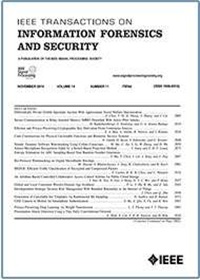Invariant Correlation of Representation With Label
IF 6.3
1区 计算机科学
Q1 COMPUTER SCIENCE, THEORY & METHODS
IEEE Transactions on Information Forensics and Security
Pub Date : 2025-04-17
DOI:10.1109/TIFS.2025.3562031
引用次数: 0
Abstract
The Invariant Risk Minimization (IRM) approach aims to address the security challenge of out-of-distribution robustness (domain generalization) by training a feature representation that remains invariant across multiple environments. However, in noisy environments, noise can distort invariant features, leading to different environment-specific losses. Current IRM-related methods such as IRMv1 and VREx underperform in these settings because they enforce uniform losses across environments. While environmental noise causes environment-specific losses, it does not alter the fundamental correlation between invariant representations and labels. Based on this observation, we propose ICorr (Invariant Correlation), which leverages this correlation to extract invariant representations in noisy settings. Unlike existing approaches, ICorr accommodates different environment-specific inherent losses while maintaining a necessary condition for identifying IRM classifiers. We present a detailed case study demonstrating why previous methods may lose ground while ICorr can succeed. Through a theoretical lens, particularly from a causality perspective, we illustrate that the invariant correlation of representation with label is a necessary condition for the optimal invariant predictor in noisy environments, where as the optimization motivations for other methods may not be. Furthermore, we empirically demonstrate the effectiveness of ICorr by comparing it with other domain generalization methods on various noisy datasets.标记表示的不变性相关
不变风险最小化(IRM)方法旨在通过训练在多个环境中保持不变的特征表示来解决分布外鲁棒性(域泛化)的安全挑战。然而,在嘈杂的环境中,噪声会扭曲不变的特征,导致不同的环境特有的损失。当前与irm相关的方法,如IRMv1和VREx,在这些设置中表现不佳,因为它们强制跨环境统一损耗。虽然环境噪声会导致环境特有的损失,但它不会改变不变表示和标签之间的基本相关性。基于这一观察,我们提出了ICorr(不变相关),它利用这种相关性来提取噪声设置中的不变表示。与现有方法不同,ICorr在保留识别IRM分类器的必要条件的同时,容纳了不同的环境特定的固有损失。我们提出了一个详细的案例研究,说明为什么以前的方法可能会失败,而ICorr可以成功。通过理论视角,特别是从因果关系的角度,我们说明了表示与标签的不变相关性是嘈杂环境中最优不变预测器的必要条件,而其他方法的优化动机可能不是。此外,我们通过将ICorr与其他领域泛化方法在各种噪声数据集上进行比较,实证证明了ICorr的有效性。
本文章由计算机程序翻译,如有差异,请以英文原文为准。
求助全文
约1分钟内获得全文
求助全文
来源期刊

IEEE Transactions on Information Forensics and Security
工程技术-工程:电子与电气
CiteScore
14.40
自引率
7.40%
发文量
234
审稿时长
6.5 months
期刊介绍:
The IEEE Transactions on Information Forensics and Security covers the sciences, technologies, and applications relating to information forensics, information security, biometrics, surveillance and systems applications that incorporate these features
 求助内容:
求助内容: 应助结果提醒方式:
应助结果提醒方式:


